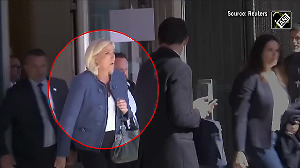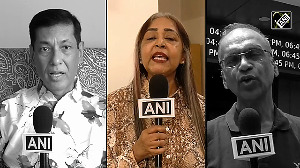At the Sula Vineyards in Nashik, five hours' drive from Mumbai, the atmosphere is festive.
Staff at India's second largest winemaker are preparing for their 10th annual harvest party in mid-March at a new amphitheatre in the vineyard, which lies in the some of the richest agricultural lands of the western state of Maharashtra.
"There will be bands and dancers. It's going to be very cool," says Rajeev Samant, the shaven-headed founder of Sula. "You can bring your blanket and sit out. Nowhere else in India can you do that in the middle of a vineyard."
With sales growing 45 per cent annually over the past three years, there is good cheer in abundance at Sula.
But it was not always this easy. While the company's New Age "solar logo" of a smiling yellow sun has become one of India's most recognised consumer brands, the winery's rise was fraught with difficulties. These ranged from tackling India's labyrinthine bureaucracy to luring the country's emerging middle-class consumers away from their traditional tipple of locally made hard liquor.
Samant says that, in its first year of sales in 2000, Sula disposed of only 4,000 cases of its first wine, a 1999 sauvignon blanc. "This year we are going to sell about 250,000 cases. That is something I could never have imagined back in the beginning."
Winemaking has a long history in India but religiously motivated curbs on alcohol consumption held back the industry after independence. Wine still accounts for only 1 per cent of sales by volume of alcoholic drinks in India, according to Business Monitor International.
The industry used to be dominated by two producers, the Indage Group, also based in Maharashtra, and Grover Vineyards near Bangalore in the south, both of which began winemaking in the 1980s. But it was only once Sula got off the ground that competition in the industry took off.
Samant, 41, started wine-making by chance. In 1993, the Stanford-trained engineer tired of corporate life in Silicon Valley - he worked as a finance manager at Oracle - and took over his father's property near their native city, Nashik. It was a 28-acre rural idyll surrounded on three sides by hills and with a lake in the distance.
He decided to try his hand at farming. "I had been reading a fair amount of philosophy and literature at Stanford and Tolstoy was someone who had influenced me. I liked his idea of a guy who was at home in the big city and the country and spends his life between both places," Samant says.
But what sort of farming? He tried organic mangoes, peanuts, roses and then table grapes, which were already common in the region. A letter from a girlfriend, in which she asked whether wine grapes were also being grown in the area, provided the inspiration for his foray into winemaking. "I said: 'Why is no one making wine here? If table grapes grow, obviously wine grapes can grow too'," Samant says.
He met Kerry Damskey, a winemaker from California's Sonoma Valley, through a business school contact and they planted Sula's first vines in 1997. His father and others provided seed capital and his former chemistry teacher was the company's first winemaker.
But setting up the winery was the easy bit. Getting government permits proved to be the real challenge. "It took me two years to persuade the local authorities that they were really being shortsighted, that they kept talking about raising rural incomes and providing rural employment and that if you weren't going to allow wine, you were cutting out something that could be huge," Mr Samant says.
The next hurdle was how to sell the wine. He decided to target the premium market, with a price of Rs 450 a bottle.
"People were shocked, saying: 'Why should we pay that much for a bottle of Indian wine?' I used to go door to door, hotel to hotel, restaurant to restaurant, trying to sell the wine. It was tough. It took us six months to sell one truckload."
Mr Samant turned to his Silicon Valley contacts, many of whom were now working in India's information technology capital, Bangalore. He started holding Sula-branded parties in Bangalore at the height of the internet boom. Investment banks and dotcom companies sponsored the parties and paid for the wine.
"Many of these dotcoms eventually went bust but we emerged with tons of press," he says.
The big breakthrough, however, came in 2003, when the government cut excise duty. This immediately gave Sula a generous boost to its margin that it could use for marketing. Today, Mr Samant claims the company has overtaken the industry number two, Grover, which he says has market share of about 10 per cent.
The potential for wine in India remains vast. Indians drink about 10ml of wine per capita each year, or between one and two tablespoons, compared with 400ml in China and 50 litres in France.
Foreign companies are also eyeing the market. But Indian winemakers are protected by a 150 per cent import tariff that critics say shields them from the salutary effects of overseas competition. "I think Indage and Sula are more on the marketing side," says one industry operator. "When you are marketing, you don't have that sort of passion to ensure quality."
Samant would dispute that. He says that at an elevation approaching 1,000m, Nashik's cool nights and hot days enhance the flavours of his wines, which include a sauvignon blanc, a chenin blanc, zinfandel, a cabernet shiraz, a reserve shiraz, a sparkling wine and a variety of rose.
This year Sula will plant another 800 acres of vineyards, bringing its total to 2,500 acres. Sales are expected to reach $22m in 2008, up 60 per cent on the previous year.
In the future, Mr Samant is pondering an initial public offering along with offshore acquisitions. Meanwhile, Nashik is booming. Since Sula set up operations there, another 29 wineries have followed suit and the region now produces most of India's wine.
As for Mr Samant, he says on his website that he cannot imagine anyone happier in his job than himself, except "Hugh Hefner, perhaps". It may be just another marketing line but, if it is, he puts on a pretty convincing act.
Small farmers savour a brighter future in Nashik's vineyards
A weather-beaten man wearing the traditional white dhoti kurta of rural India wanders into Sula's trendy wine-tasting balcony overlooking its vineyards in Nashik.
The man is a local farmer. Until a few years ago he was unlikely to have heard of wine but today has become an essential figure in one of India's fastest-growing rural industries.
Rajeev Samant, Sula's founder, says the winery has transformed the lives of people in nearby villages. Today it employs at least one person per family from the settlement closest to the vineyard.
"My first employee was from that village. Today he's our cellar supervisor. Then his brother joined, then his cousin, his other cousin and his third cousin joined - there are only two last names in the entire village," jokes Samant.
Sula's biggest task is to educate contract farmers in how to grow grapes for wine rather than for eating. Yields from winemaking vines should be much lower than those for eating. To help, Sula has started sending its 25 biggest contract farmers on overseas visits to vineyards.
"A cabernet sauvignon is a late maturing grape. You need to wait to get the late flavours," says Ajoy Shaw, Sula's chief winemaker. "But farmers panic if they see any grape having a little bit of shrivel."







 © 2025
© 2025